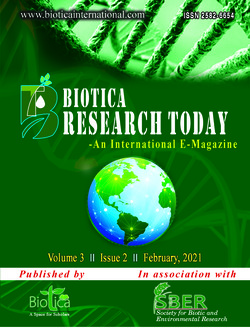
Concepts of Immunity and Recent Immunization Programme against COVID-19 in India
Jyoti Prakash Sahoo*
Dept. of Agricultural Biotechnology, OUAT, Bhubaneswar, Odisha (751 003), India
Sudhanya Nath
Dept. of Animal Nutrition, West Bengal University of Animal & Fishery Sciences, Kolkata, West Bengal (700 037), India
Lipi Ghosh
School of Development Studies, TISS, Mumbai, Maharashtra (400 088), India
Kailash Chandra Samal
Dept. of Agricultural Biotechnology, OUAT, Bhubaneswar, Odisha (751 003), India
DOI: NIL
Keywords: Vaccine, COVID-19, Immune response, Co-WIN
Abstract
To safely achieve herd immunity against COVID-19, a substantial proportion of a population would need to be vaccinated, lowering the overall amount of virus able to spread in the whole population. India has leveraged its manufacturing capacity to pre-order 600 million doses of potential COVID-19 vaccine and negotiating for another billion doses, says a new global analysis of advance market commitments (AMC) for vaccine candidates against the corona virus. India is planning to start the distribution of COVID-19 vaccine first to the healthcare workers followed by other groups to be added sequentially as there are five COVID-19 vaccines under trials in India such as COVAXIN, Covishield, ZyCoV-D, Sputinik and Biological E’s novel Covid-19 vaccine. Out of these five, COVAXIN and Covishield are approved by DCGI (Drugs Controller General of India) for restricted use in emergency situation.
Downloads
not found
Reference
Sahoo, Jyoti Prakash, Mohapatra, Upasana, Mahapatra, Sushree, Panda, Koustava, Ganesh, Pushpalatha, Mishra, Ambika, Samal, Kailash, Behera, Suraj, 2020. An Immunological Outlook on SARS Coronavirus (SARS-CoV-2) and Its Current Clinical Status. Journal of Pharmaceutical Research International 32, 37-59. 10.9734/JPRI/2020/v32i2630838.
Behera, Laxmipreeya, Sahoo, Jyoti Prakash, Mahapatra, Sushree, Praveena, J., Dash, Trupti, Samal, Kailash, 2021. Insights into the SARS-CoV-2 Diagnosis in India: Present Status and Future Prospects. Journal of Pharmaceutical Research International 32, 38-53. 10.9734/JPRI/2020/v32i3931023.
